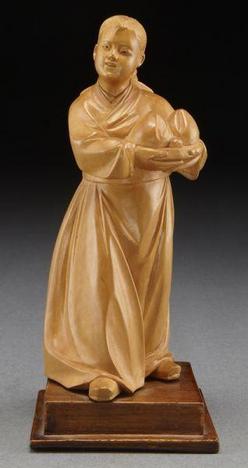 It’s a rare thing when we say, “Wow! I’ve never seen one of those before!” We see nicer examples, more complete examples, more unusual examples of things we’ve seen before, but every now and then, we come across some objects with a context that’s completely new to us. That’s how I felt when I encountered several groups of artwork from the Chinese Cultural Revolution. After the push to rapidly industrialize China during the Great Leap Forward in the late 1950s and early 1960s, Mao began to feel as though he had lost some authority specifically to Liu Shaoqi and other rivals in the Chinese Communist Party, and more generally to a visible and burgeoning middle class populated by engineers, factory managers, and other science- or technology-minded citizens. (Ironically, it’s the rise of a new middle class in China today, along with the weaker value of the U.S. dollar, that is driving a rapidly growing market for Asian material, much of which is being repatriated.) Mao’s vision of communism sought an idealized classless society, and he used that vision to spark the Cultural Revolution, a movement whose sophisticated and gentle name belies the violence and turmoil it inspired throughout China. (Estimates of those killed range from 500,000 to 20 million and will likely never be accurately known.) The Cultural Revolution resulted in huge, sweeping changes in China to attitudes, policies, and even artwork.
It’s a rare thing when we say, “Wow! I’ve never seen one of those before!” We see nicer examples, more complete examples, more unusual examples of things we’ve seen before, but every now and then, we come across some objects with a context that’s completely new to us. That’s how I felt when I encountered several groups of artwork from the Chinese Cultural Revolution. After the push to rapidly industrialize China during the Great Leap Forward in the late 1950s and early 1960s, Mao began to feel as though he had lost some authority specifically to Liu Shaoqi and other rivals in the Chinese Communist Party, and more generally to a visible and burgeoning middle class populated by engineers, factory managers, and other science- or technology-minded citizens. (Ironically, it’s the rise of a new middle class in China today, along with the weaker value of the U.S. dollar, that is driving a rapidly growing market for Asian material, much of which is being repatriated.) Mao’s vision of communism sought an idealized classless society, and he used that vision to spark the Cultural Revolution, a movement whose sophisticated and gentle name belies the violence and turmoil it inspired throughout China. (Estimates of those killed range from 500,000 to 20 million and will likely never be accurately known.) The Cultural Revolution resulted in huge, sweeping changes in China to attitudes, policies, and even artwork.
As part of the Cultural Revolution, anything bourgeois was violently rejected and that included art. All artwork was to promote the worker, the individual without promoting individualism, and to depict well-fed, cheerful Chinese citizens (like the beaming young woman pictured above) working hard but happily at daily jobs, preferably those that were seen as the cornerstones of communism – the worker and the farmer. Carvings and sculptures of farmers plowing the fields, fishermen pulling their nets, workers surveying their accomplishments, seem to project a peacefulness and contentment, rather reminiscent actually of the American Regionalist artistic movement headed by Grant Wood a few decades earlier, that makes one feel life is simple and pleasurable for those who work hard and contribute to the world in which they live. At the same time, when placed in the murky context of the Chinese Cultural Revolution, these pieces seem to carry a darker, more sinister weight, contributing to the eternal discussion of how art changes with or without the historic, social, and artistic framework.



